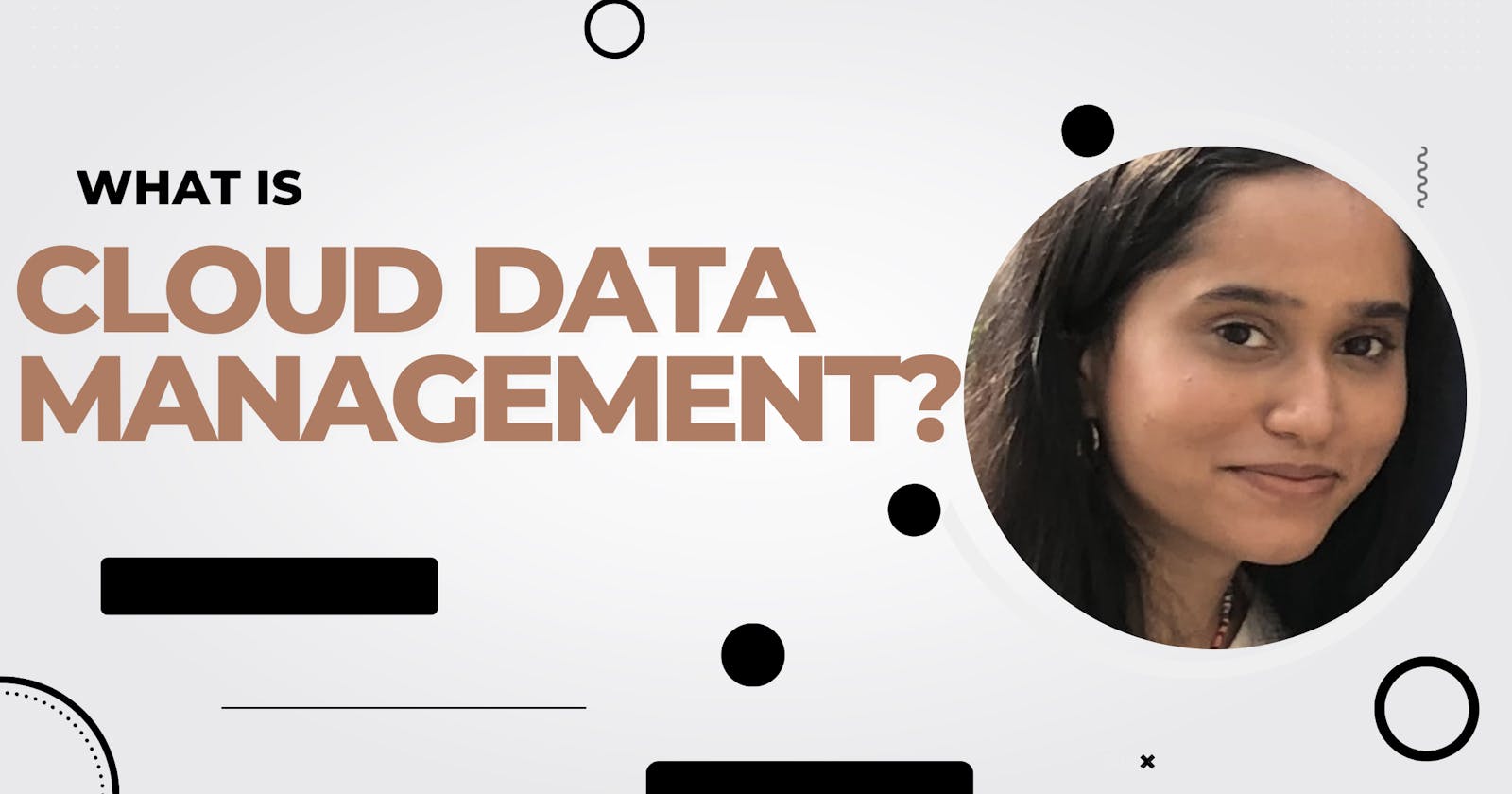Data Management in the Cloud
Ever wondered how data is stored, secured, and analyzed in the cloud? Let's find out!
TABLE OF CONTENTS: |
What is Data Management? |
Why Data Management? |
Cloud Data Management |
Cloud-Based Data Storage Solutions |
Exploring Database Migration Strategies and Best Practices |
Touch on Big Data Analytics and Data Warehousing Options in AWS |
Conclusion |
What is Data Management?
The term Data Management usually refers to the act of collecting, storing, securing, and using an organization's data. Because organizations today have multiple data sources from which the data needs to be analyzed and integrated to derive insights for strategic planning, data management also refers to the policies and procedures that enhance data usability while adhering to the laws and regulations. However, it is a crucial practice in the modern digital age, where massive amounts of data are generated, collected, and utilized for various purposes.
Why Data Management?
Over the decades, data has usually been seen as a driving force for many organizations across the globe. With access to large volumes and different data types, there have been significant investments in data storage and management infrastructure by many organizations. Most of them use data management systems to run business intelligence and data analytics operations and procedures efficiently.
Some of the data management capabilities are listed here as follows:
Informed Decision-Making: Proper data management ensures that decision-makers have access to accurate, relevant, and up-to-date information. This helps organizations to make data-driven decisions that result in better outcomes and strategic planning.
Collaboration: Data management promotes better organizational collaboration. Teams can collaborate more effectively, exchange insights, and contribute to common goals when data is organized and accessible.
Scalability: As an organization grows, so does the volume of data. Effective data management guarantees that systems and processes can scale to meet this increased demand without losing performance or data quality.
Cloud Data Management:
Data management in the cloud is a way to manage data across various cloud platforms and cloud solutions, instead of using traditional on-premises data centers for storing, organizing, and managing the data. Organizations are increasingly recognizing the importance of shifting their workloads to the cloud, leveraging the cloud's role to optimize new products and services and decrease CapEx and OpEx. As enterprises continue to migrate IT applications and operations to the cloud, there is a critical and strategic need for cloud-centric data management tools and platforms capable of managing all types of data.
Cloud-Based Data Storage Solutions:
Before we look at the different data storage solutions provided by Amazon Web Services (AWS), one of the leading cloud providers around the world, let us have a look at some of the key tenets of cloud data management platforms (also known as cloud lake house data management platforms), which include:
They are API-driven and supplied in the form of microservices.
For faster and more scalable deployment, they use modern constructs like serverless and containers.
They are easy to set up and install.
They are also pretty simple to manage, as they include automatic upgrades and patch management.
Moving ahead, millions of customers these days use AWS storage services to transform their businesses, reduce costs and administrative overhead, and accelerate innovation. AWS, on the other hand, also provides a wide range of storage solutions with deep functionality for storing, protecting, and analyzing data.

Storage and Databases:
The key storage services in AWS, ranging from object and file storage to block-level storage, are as follows:
Amazon Simple Storage Service (S3):
In AWS, S3 is the default storage location for data ingestion and output for many AWS services. This is the object-level storage option. This means that the data is stored in the form of objects. Buckets are containers where objects are stored. All the objects/folders are stored inside the buckets. Also, there is no limit to the number of objects stored in a bucket (unlimited). However, the object size ranges from "0 bytes to 5TB per object".
Amazon Elastic Block Store (EBS):
In AWS Elastic Block Store (EBS), the block-level storage solution. Block storage can be described as the raw disk allocations (volumes), which can be encrypted using one of AWS's services: Key Management Service (KMS). Instances usually see the block devices and create file systems on these devices. When it comes to EBS, storage is provisioned in only " one AZ (Availability Zone)". EBS volumes can be detached and reattached to the instances at any moment and are not linked to the lifecycle of these EC2 instances.
Amazon Elastic File System (EFS):
Amazon EFS allows you to create and configure shared file systems simply and quickly for AWS compute services. This service also eliminates the need for capacity planning because it provides fully elastic performance and storage. This is also designed for 99.99999999999 percent (11 9's) durability and 99.9999 percent (4 9's) availability. EFS automatically grows and shrinks as we add or remove files with no need for management or provisioning.
Some of the database services offered by AWS are highlighted below as follows:
Relational Database Service (RDS):
Amazon Relational Database Service (RDS) is a combination of managed services that makes it easy to set up, run and scale databases in the cloud. RDS is compatible with MySQL, PostgreSQL, MariaDB, Oracle, and SQL Server. We can also deploy on-premises with Amazon Outposts. Some of the current customers using RDS in integration with other databases include- Samsung, Cathay Pacific, and Intuit Mint.
DynamoDB:
Amazon DynamoDB is a fully managed and serverless No-SQL Database engine for any scale. It is also called a key-value database. One of the most important characteristics of DynamoDB is its ability to deliver single-digit millisecond performance at any scale. It can also handle more than 10 trillion requests per day and support peaks of more than 20 million requests per second, making it one of the most important databases used by some of the world's fastest-growing businesses such as Airbnb, Redfin, and Lyft, as well as enterprises such as Toyota, Capital One, etc.
Exploring Database Migration Strategies and Best Practices:
Database migration, in short, refers to the transfer of data from one platform to another. A company or organization usually opts for database migration for different reasons. For instance, an organization may believe that a particular database (e.g.: MySQL) offers characteristics that can provide greater benefits than their current database (e.g.: Oracle). Alternatively, businesses may choose to save money by migrating their old on-premises systems to the cloud. Having said that, migrating the data from one platform to another is not an easy task. The most common mistakes are the lack of a proper database migration plan and poor execution. Simply put, a good database migration plan can help businesses avoid overspending and missing deadlines. To achieve this, Amazon Web Services (AWS) offers some services and resources that help in laying out an effective migration plan to successfully migrate databases to the cloud. Here are a few services provided by AWS in this regard:
AWS Database Migration Service (DMS):
AWS Database Migration Service (DMS) is a fully managed migration service that assists in migrating your databases and analytical workloads to AWS securely and rapidly with no data loss and minimal downtime for any applications. It also supports homogenous and heterogenous database migrations from Oracle, PostgreSQL, SQL Server, MySQL, MariaDB, and other databases. AWS Database Migration Service can also be used for continuous data replication with high availability.
AWS Application Migration Service:
AWS Application Migration Service allows one to quickly realize the benefits of migrating applications to the cloud without any changes and with minimal downtime. The AWS Application Migration Service minimizes error-prone manual processes by automatically converting the source servers from physical, virtual, or cloud infrastructure to run natively on AWS. This service further simplifies the migration process by using the same automated processes for a wide range of other applications.
Legacy data does not always match the new system. Bringing superfluous data to a new system is a waste of time, money, and resources. On the other hand, a good database migration strategy can handle these challenges by defining the key data requirements and guiding you to the proper decisions. A good plan assists the data migration team in avoiding creating a terrible experience that frequently causes more problems than it solves. A poor plan might cause the team to miss deadlines, and go over budget, which would further result in a failed project. According to a study, database migration can result in cost overruns of more than $250,000.

Touch on Big Data Analytics and Data Warehousing Options in AWS:
The big data ecosystem is growing quickly. Different AWS services, such as AWS Lambda, Amazon OpenSearch Service, Amazon Kinesis Firehose, and Amazon Machine Learning. There have been significant enhancements to the existing analytics offerings, such as those supporting JSON documents in DynamoDB and adding Spark and Presto on Amazon EMR.
Big data tools and technologies provide opportunities and challenges in efficiently analyzing the data to better understand customer preferences, acquire a competitive advantage in the marketplace, and develop one's business.
AWS's Whitepaper on big data analytics options helps you understand when to choose one solution over the other. It covers ideal usage patterns, performance, durability, scalability, and elasticity. AWS offers a comprehensive platform of managed services to help you quickly and easily construct, scale, and protect your big data applications from end to end. If you would like to know more about these services, I'm attaching the link to this document, feel free to check it out.
Link to AWS Whitepaper on Big Data Analytics: http://d0.awsstatic.com/whitepapers/Big_Data_Analytics_Options_on_AWS.pdf
Enterprises and businesses all over the world seek to move data warehousing to the cloud to increase performance and reduce expenses.
Introducing Amazon Redshift:
In the past, many enterprises struggled with maintaining a healthy relationship with traditional database vendors. They were frequently obliged to either upgrade hardware for a managed system or enter a protracted negotiation cycle for a term license that had expired. Cloud data warehouses such as Amazon Redshift have transformed the way businesses think about data warehousing by drastically reducing the cost and effort associated with establishing warehouse systems while maintaining their functionality, size, and performance. Amazon Redshift is an automated data warehousing solution, which is a simple and cost-effective solution to analyze large volumes of data using the existing Business Intelligence tools (BI).
If you would like to know more about Data Warehousing in AWS, check out:
Conclusion:
Cloud data management has been swiftly evolving from outdated locally hosted storage systems to a far more versatile and dependable cloud data management module. Although local data storage was formerly the industry standard, this preference is shifting as businesses become more aware of the innovations in cloud storage technologies. Over the next few years, more and more businesses will embark on digital transformation programs and shift to the cloud as their preferred way of managing data. Data will become increasingly important in the organization's ability to remain competitive in its respective areas. This estimate further emphasizes establishing and maintaining an efficient data management framework that will enable the companies to keep up with a fast-paced and continuously changing business landscape.
Lastly, thank you so much for sticking through the whole article. By now, I hope you have something useful to take away from this. This is my first blog on data and the cloud. I will write more articles and blogs explaining the importance of moving to the cloud and adopting cloud-based solutions for different uses in our everyday lives.
Thank you, until next time! See you soon, Cheers :)

